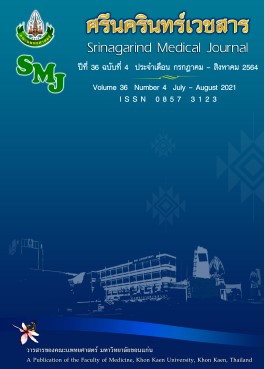ความรู้และพฤติกรรมการใช้ยาพาราเซตามอลของประชาชนแขวงนวมินทร์ เขตบึงกุ่ม กรุงเทพมหานคร
คำสำคัญ:
ความรู้; พฤติกรรม; การใช้ยาพาราเซตามอลบทคัดย่อ
หลักการและวัตถุประสงค์: ยาพาราเซตามอลเป็นยาสามัญประจำบ้านที่สามารถหาซื้อได้ทั่วไป และนิยมนำมาใช้ในการบรรเทาอาการปวดด้วยตนเอง ดังนั้นการศึกษานี้จึงมีวัตถุประสงค์เพื่อศึกษาความรู้และพฤติกรรมการใช้ยาพาราเซตามอลของประชาชนแขวงนวมินทร์ เขตบึงกุ่ม กรุงเทพมหานคร
วิธีการศึกษา: เป็นการศึกษาเชิงพรรณนาแบบภาคตัดขวางในประชาชนแขวงนวมินทร์ เขตบึงกุ่ม กรุงเทพมหานครจำนวน 396 ราย เก็บข้อมูลโดยใช้แบบสอบถามชนิดตอบด้วยตนเอง
ผลการศึกษา: ผู้เข้าร่วมงานวิจัยส่วนใหญ่มีระดับความรู้การใช้ยาพาราเซตามอลอยู่ในระดับปานกลาง และมีคะแนนความรู้การใช้ยาพาราเซตามอลเฉลี่ย 6.37±2.04 คะแนน จาก 12 คะแนน โดยประเด็นคำถามที่มักจะมีความรู้ที่ไม่ถูกต้องมากที่สุด คือ ‘การรับประทานยาพาราเซตามอลมากเกินไปจะเป็นพิษต่อไต’ ส่วนพฤติกรรมการใช้ยาพาราเซตามอล พบว่าผู้เข้าร่วมงานวิจัยมีคะแนนพฤติกรรมการใช้ยาพาราเซตามอลเฉลี่ย 5.73±1.11 คะแนน จาก 7 คะแนน โดยประเด็นคำถามที่มักปฏิบัติไม่ถูกต้องมากที่สุด คือ ‘จำนวนเม็ดที่ใช้ยาพาราเซตามอลในแต่ละครั้ง’ โดยปัจจัยด้านระดับการศึกษา อาชีพหลัก รายได้ในครัวเรือน และผู้ที่มีโรคตับมีผลต่อความรู้การใช้ยาพาราเซตามอลอย่างมีนัยสำคัญทางสถิติ (p=<0.001, 0.022, 0.005 และ 0.031 ตามลำดับ) ส่วนปัจจัยด้านระดับการศึกษามีผลต่อพฤติกรรมการใช้ยาพาราเซตามอลอย่างมีนัยสำคัญทางสถิติ (p=0.012) และไม่พบความสัมพันธ์ระหว่างความรู้การใช้ยาพาราเซตามอลกับพฤติกรรมการใช้ยาพาราเซตามอลอย่างมีนัยสำคัญทางสถิติ
สรุป: ประชาชนในแขวงนวมินทร์ เขตบึงกุ่ม กรุงเทพมหานคร มีความรู้เกี่ยวกับการใช้ยาพาราเซตามอลระดับปานกลาง และประชาชนบางส่วนยังมีพฤติกรรมเกี่ยวกับการใช้ยาพาราเซตามอลที่ไม่เหมาะสม เภสัชกรควรมีบทบาทในการแก้ไขความรู้และความเข้าใจที่ไม่ถูกต้อง และหาแนวทางปรับเปลี่ยนพฤติกรรมเพื่อให้ประชาชนมีการใช้ยาพาราเซตามอลอย่างถูกต้องและสมเหตุผลต่อไป
เอกสารอ้างอิง
2. Drug system monitoring and development centre (dmdc). Warning: drug-induced hepatotoxicity [Internet]. 2016 [cited Aug 6, 2018]. Available from: https://www.thaidrugwatch .org/ blog/?p=1180.
3. Drug Safety and Risk Management Advisory Committee. Acetaminophen overdose and liver injury – background and options for reducing injury [Internet]. 2017 [cited Aug 6, 2018]. Available from: https://www.fda.gov/downloads/AdvisoryCommittees/Committees MeetingMaterials/Drugs/DrugSafetyandRiskManagementAdvisoryCommittee/UCM164897.pdf.
4. Saengcharoen W, Buasri N, Khantapokha B, Lerkiatbundit S. Public knowledge and factors associated with inappropriate analgesic use: a survey in Thailand. Int J Pharm Pract 2016; 24: 22-29.
5. Dokken W. Analgesic use of people in Chanthuek community Nongsarai sub-district Pakchong district, Nakhonratchasima province. Community Health Development Quarterly Khon Kaen University 2017; 5: 476-486.
6. Rakphong T, Yaprasert P. Knowledge and behaviors of paracetamol uses among students in Chiang Mai University [Doctor of Pharmacy Program]. Chiang Mai: Chiang Mai University; 2014.
7. Official Statistics Registration Systems. Report of annual population and house statistics 2017 [Internet]. 2017 [cited Aug 6, 2018]. Available from: https://stat.dopa.go.th/stat/statnew/ statTDD/views/showZoneData.php?rcode=1027&statType=1&year=60.
8. Yamane T. Statistics: an introductory analysis. 3rd edition. New York: Harper and Row Publishers; 1973.
9. Announcement of the Ministry of Public Health. Over-the-counter drug (no.7) 2017. Royal Government Gazette 134 special section (dated 4 April 2017).
10. Mehrens WA, Lehmann IJ. Measurement and education in evaluation and psyschology. New York: Holt; 1984.
11. Stumpf JL, Skyles AM, Alaniz C, Erickson SR. Knowledge of appropriate acetaminophen doses and potential toxicities in an adult clinic population. J Am Pharm Assoc 2007; 47(1): 35-41.
12. Tariq M, Din FU. Poor knowledge of university students regarding paracetamol; a wakeup call for public healthcare practitioners. Cogent Med 2017; 4: 1-12.
13. Dawood OT, Hassali MA, Saleem F. Factors affecting knowledge and practice of medicine use among the general public in the state of Penang, Malaysia. J Pharm Health Serv 2017; 8: 51-57.
14. Sriuttha P, Suwannaprom P, Niwatananun K. Drug use behaviors and potential risk of hepatotoxicity: a case study of paracetamol in Chiang Mai. Thai Bull Pharm Sci 2018; 13(2): 25-40.




